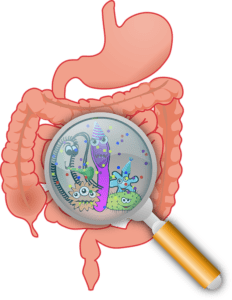
How to Beat the Bloat with FODMAPs
(Low FODMAP Diet Explored)
Do you experience digestion issues but are uncertain of your food triggers? If so, you are not alone. One in seven people experience Irritable Bowel Syndrome, characterized by symptoms’ of bloating, pain, gas and changes in bowels (i.e. diarrhea or constipation). While many may shy away from talking about their digestive woes, in my office, this is a common (and very important) conversation. Today, I will share a dietitian’s perspective on treating digestive issues (like abdominal pain, bloating and loose bowels) with the Low FODMAP diet.
DYK: More than 20 million Canadians suffer from general digestive disorders every year (Can. Digestive Foundation, 2018) Click To TweetThe Low FODMAP diet is a favourite diet to coach clients on because it is so effective and it’s extremely exciting to monitor symptom improvement. In today’s blog, you will learn how this science-based diet alleviates digestive distress and what the low FODMAP journey may look like. We will also explore why receiving support of a specialized FODMAP dietitian is recommended.
Discover how the Low #FODMAP diet relieves IBS symptoms! Click To TweetWhat is the Low FODMAP Diet?
The Low FODMAP diet is the first scientifically proven diet to help in relieving symptoms of Irritable Bowel Syndrome (IBS) and inflammatory bowel conditions like Crohn’s disease and colitis. In 2005 Sue Shepherd and Peter Gibson, researchers from Monash University in Australia, developed this diet (J Gastroenterol Hepatol. 2017).
The term FODMAP describes a collection of short-chain sugars that are poorly digested in the gut. For people with IBS, these (poorly digested) sugars can trigger symptoms of abdominal pain, bloating and changes in bowels when they are broken down (or fermented) by colon bacteria. FODMAPs cause the bowel to distend by drawing more fluid and generating more gas by gut bacteria fermentation.
The main principle of the Low FODMAP diet is to replace sugars that are high in FODMAPs (poorly digested sugars) with sugars that are Low in FODMAPs (easily breakdown in the stomach). This relieves digestive distress and decreases the fermentation of sugars in the colon, which often triggers symptoms. Research shows that 3 out of 4 people find tremendous relief on this diet (The Complete Low-FODMAP Diet, 2013).
The FODMAP Acronym Stands For:
- F – Fermentable (sugars that are rapidly broken down by bowel bacteria)
- O – Oligosaccharides – (less than 10 sugars – Fructans & GOS)
- D – Disaccharides – (two sugar molecules – Lactose)
- M – Monosaccharides – (one sugar molecule – Fructose)
- A – And
- P – Polyols – (sugar alcohols – Sorbitol, manitol, etc.)
*Please note, don’t let the sciencey jargon bog you down. Instead, we focus on how to identify FODMAPs and implement substitutes that are easier to digest to relieve symptoms.
Research shows that 3 out of 4 people find tremendous relief on the Low #FODMAP diet for #IBS and #IBD Click To TweetWhat Does the FODMAP Journey Look like?
If you are experiencing uncomfortable digestive symptoms, the Low FODMAP diet might help. It is recommended to mention your digestion concerns with your family doctor and consult with a registered dietitian specialized in digestion and the Low FODMAP diet. Your dietitian will likely request that you fill out a Food Symptom Journal for a minimum of two to three days. It is important to avoid changing your diet before meeting with your dietitian. Also, keep as much detail as possible for portions and corresponding descriptions of symptoms. Your dietitian will review background medical and health history, food intake and symptoms, and will assess if there is potential benefit for following this diet.
The Low FODMAP diet has a lot of intricacies in which foods have FODMAPs and the maximum portions to be consumed at a time. For example, you can have 10 almonds on the diet but more than this amount becomes high FODMAP. Working with a dietitian is recommended by Monash University to ensure that you’re following the diet correctly to receive maximum symptom benefit and not compromising nutrition with the eliminations. Your dietitian can also help guide you to the reintroduction phase, which will be described more below.
Wonder what the #LowFODMAP journey looks like? 3 phases of the diet for #IBS & #IBD Click To Tweet3 Phases of the Low FODMAP Diet:
1. The first phase is the “Elimination Phase”:
This is where clients remove foods that are High in FODMAPs and replace them with Low FODMAP alternatives. Symptoms of digestive discomfort are monitored in your Food Symptom Journal along with portions. Generally, this elimination phase may take 2 to 6 weeks. Your dietitian will recommend a check-in during this phase. The diet does not remain in the elimination phase.

2. Troubleshooting & Monitoring:
When implementing the Low FODMAP diet, clients check in with their dietitian to troubleshoot and monitor symptom change. This allows your dietitian to assess adherence and understanding of the diet along with when symptoms are experienced. Further guidance is provided to tweak commonly made mistakes (which may result in symptoms) when following the diet. Your dietitian will also ensure you’re receiving adequate, balanced nutrition and can suggest recipes and snack ideas.
3. The “Reintroduction Phase”:
This phase occurs when clients are symptom free for at least five days. This is always an exciting time! It is imperative that symptoms are calm so we can proceed to test FODMAP sugars and monitored tolerance. There are specific FODMAP food challenges. From the results of the challenges, your dietitian will summarize and determine a customized ‘digestion diet’ that reduces only the FODMAPs that your body responds negatively to (with bloating, pain, gas and loose bowels or constipation).
Find out the 3 Phases of the #LowFODMAP diet & how it can help for #IBS! Click To TweetBottom Line:
If you are experiencing symptoms of abdominal pain, bloating, gas and changes in bowels from diarrhea to constipation, you may find tremendous symptom relief from the Low FODMAP diet. Monash University developed the first scientifically proven diet to relieve symptoms for many experiencing IBS, Crohn’s disease and colitis. This diet transitions through three stages and initially replaces sugars that are difficult to digest with sugars that are easier to digest (Low FODMAP). It is recommended that this diet is followed along with a specialized dietitian in digestion and FODMAPs.
What do you think? Have you heard of the Low FODMAP diet before? Feel free to share your experience with us.







